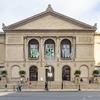More about The Races at Longchamp
- All
- Info
- Shop

Contributor
Forget watching the Kentucky Derby on TV. If you’re looking for a daring view, go ahead and stand in front of Edouard Manet’s The Races at Longchamp to get the blood pumping.
The Races at Longchamp focuses on a specific moment of the race, an intense, frenzied moment when the horses are stampeding past the finish line (indicated by the pole with the circular hole). The jockeys are intent on their goal, and the crowd is going wild. Never had there been a painting showing the horses racing towards you, the viewer. Indeed, The Races at Longchamp was the first to show this perspective. It's better than any televised viewing today.
It was all thanks to Edgar Degas that Manet showed any interest in horse racing. Degas was busy executing his own racecourse paintings at the time. The two Impressionists were bffs by 1866, and attended the races together. There’s a good chance they were betting on horses and drinking flutes of champagne alongside French and English spectators. Not to mention wearing those fabulous outfits. The races were attended by the upper-class of society, often including the Parisian males who were friends and associates of the artist and his racetrack buddy, Degas. Manet’s depiction of this upper-class pastime piqued the interest of English composer Frederick Delius. The Races at Longchamp was bought by the composer, who had an interest in Manet’s depiction of contemporary, upper-class society. It pays to hang out with horsies.
At the time, Paris was moving just as fast as the horses across the track. The industrial revolution was rapidly changing Paris. The races were but one source of entertainment among others that distracted the men of Paris. This was the scene to be seen at and to socialize in. While the spectators were ignoring the horses and opting to gossip with their friends, Manet honed in and took note of the surrounding scene. As a result, Manet completed several watercolors and oil paintings of the Longchamp races. It's almost as if the races were made to be painted by an Impressionist like Manet, whose blurry, visible brushstrokes exquisitely capture the motion and intensity of the moment.
Sources
- Crisci-Richardson, Roberta, Mapping Degas: Real Spaces, Symbolic Spaces and Invented Spaces in the Life and Work of Edgar Degas (1834-1917). Cambridge: Cambridge Scholars Publishing, 2015.
- Herbert, Robert L., Impressionism: Art, Leisure, and Parisian Society. Yale University, 1988.
- The Local, “Are these the best places in and around Paris to bring up children?” May 24, 2018. Accessed March 22, 2020. https://www.thelocal.fr/20180524/are-these-the-best-towns-around-paris-…
- Tinterow, Gary, Loyrette, Henri, Origins of Impressionism. New York: The Metropolitan Museum of Art, 1994.
- Walter, Emily, Cachin, Francoise, Moffet, Charles S., Manet. New York: Bradford D. Kelleher, Publisher, 1983.
Featured Content
Here is what Wikipedia says about The Races at Longchamp
The Races at Longchamp is an 1866 painting by the French artist Édouard Manet. The Impressionist painting depicts the ending of the Second Grand Prix de Paris at Longchamp. It is currently in the collection of the Art Institute of Chicago. This painting is one of four depictions of the same subject that Manet created over four years. The painting reflects the rise of horse racing in France, following the influence of the British. The work is thought to be the first painting to present horses coming directly toward the viewer, and it uses various techniques to reduce the sense of depth.
Check out the full Wikipedia article about The Races at Longchamp














